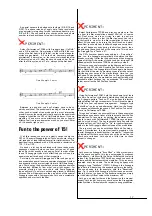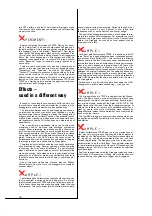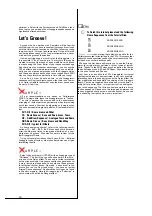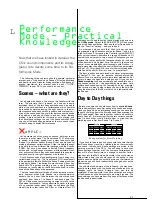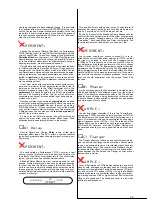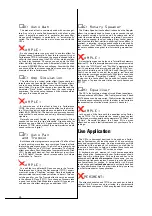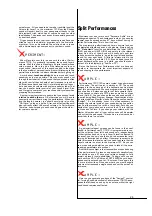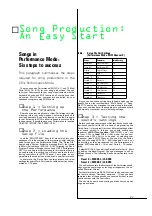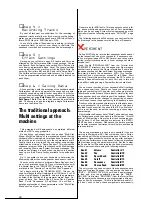
13
helps to accentuate the interplay between the two LFOs
(TP043). Even ‘analogue echo effects’ can be achieved with
the LFO. For this, the sawtooth wave is most appropriate. You
will need to play ‘staccato’ (release the keys quickly) in order
to get these echo effects (TP044).
Everything sounds reasonable so far. But what does Init
Phase do? Don’t panic, all shall be revealed: as the name
suggests, this function is used to determine the LFO’s gen-
eral phase setting. All of the CS1x Low Frequency Oscillators
can be synchronised to each key press using the ”Retrigger”
option. When this is set, a sound’s modulation begins exactly
when a key is pressed (TP045), something which is usually
desirable. Now all LFOs are running in phase, there is no vari-
ation between each separate voice. Should you wish to
involve a little randomness in this process however take a
look at ”Freerun” (TP046). Both examples demonstrate
nicely how the different phase settings affect a sound.
About the Little Things
Now that we’re approaching the end of our little workshop
we should take a look at what effect the monophonic mode
has on the Portamento function and other sound parameters,
features which are so often neglected. This is a shame
because as in life, it’s the little things that count.
The Mono/Poly setting determines whether a sound can
play many notes at once or just one at a time. To save on
voices? No, this time it’s not a case of economics, it simply
wouldn’t make sense. Instead, the Mono function is a tool to
replicate specific playing techniques used with analogue
synthesizers.
A M P L E :
All monophonic synths respond in a certain way when a
second note is pressed whilst the first is still being held. Inci-
dentally, a polyphonic synthesizer’s Unison Mode does
exactly the same thing, i.e. all voices are assigned to a single
note – every new voice cuts off the previous, which resur-
faces however when the new note is released. This effect is
used to produce fast trills in synth solos. To demonstrate,
here’s a sound which you can play polyphonically first
(TP047), and then monophonically (TP046). Comparing the
two modes should give you a good insight into the practical
uses of the Mono function.
The difference between the Mono and Poly mode is even
more pronounced when used in conjunction with the Porta-
mento feature (Porta Switch or via Controller #65). This
parameter is also part and parcel of synthesizer playing tech-
niques. The Portamento function principally enables step-
free gliding from one tone to the next, one of electronic
music’s most fundamental stylistic tools. The Portamento
speed has to be selected according to the sound and inter-
pretation used. With the sequencer this can be achieved with
Controller #5 (Portamento Time).
A M P L E :
It is often required to be able to vary the glissando effect on
impulse during a live performance. This can be particularly
useful with different solo phrases. Setting Assign1 to the
PortaTime function will allow you to control the Portamento
speed with Knob3. The Performances TP049/050 will dem-
onstrate this nicely. Pay particular attention to the Porta-
mento differences in the Poly and Mono modes. Try varying
the Portamento speed and observe how the CS1x reacts. A
little time and effort is all it takes to deliver impressive synth
solos to an appreciative audience – practise makes perfect!
The Mono mode in conjunction with the Portamento Func-
tion can approximate the Single Trigger Mode, made popu-
lar by many Minimoog bass lines: when two keys are held
down at the same time during legato style playing, the
second note’s attack phase (usually a typical filter sweep) is
inaudible – the first note’s envelope stays uninterrupted.
Only when the current key is released will the second note’s
envelope come into effect.
PERIMENT:
To make all this a little clearer, call up Performance TP051.
Playing this bass sound staccato style will produce a percus-
sive filter attack for each note. During legato playing how-
ever only the first note’s attack is heard. Why? Simple: the
Portamento function is in effect, although the characteristic
pitch glide is missing. This is achieved by setting the Porta-
mento speed to 0 – a little trick, used here to great effect. If
you want Portamento however, simply adjust the speed for
the required effect. Now disable the Single Trigger Mode
(TP0520). Trill a few notes, and you will find that many play-
ing techniques and much phrasing is now impossible.
The Portamento Function
can be activated for each Layer
Lastly, the somewhat tricky subject of Touch Sensitivity.
The CS1x offers no fewer than four related functions (see
section “Performance”, “Velocity” in the manual). More often
than not you will want to finely tune a Performance’s touch
dynamic individually. How is this achieved?
PERIMENT:
The Performance’s touch sensitivity can be set using the
Velocity Offset function. In order to fully exploit the whole
dynamic range, Velocity Depth should be set to maximum
127. Select Performance TP053. Now gradually increase the
Offset value. See what happens? The touch sensitivity is
beginning to stabilise. This sounds great. Unfortunately the
tone is getting brighter. That’s not quite right! Why is this
happening? The culprit here is the Material Voice. It is pro-
grammed to increase the filter frequency with increasing key
velocity. Therefore, increasing the offset value also increases
the sound’s harmonic overtones. Beware – many other
sounds exhibit this behaviour too when their touch sensitiv-
ity values are changed.
Many sound creators take particular pride in their famous
Velocity Switch sounds. To prove the point we have created
four sounds, which will demonstrate the practical uses of
velocity switching.
A M P L E :
The Performance’s touch sensitivity can be set using the
Velocity Offset function. In order to fully exploit the whole
dynamic range, Velocity Depth should be set to maximum
127. Select Performance TP053. Now gradually increase the
Offset value. See what happens? The touch sensitivity is
beginning to stabilise. This sounds great. Unfortunately the
tone is getting brighter. That’s not quite right! Why is this
happening? The culprit here is the Material Voice. It is pro-
grammed to increase the filter frequency with increasing key
Portament
Time
0
Sw
1
2
3
4


















